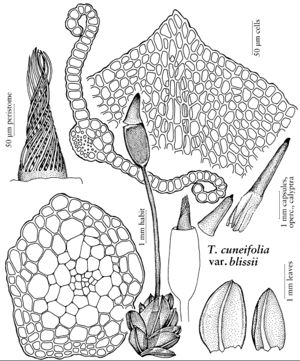Tortula cuneifolia var. blissii
Bull. Buffalo Soc. Nat. Sci. 32: 223, plate 85, figs. 21–25. 1993,.
Leaves short- to long-ovate, apex broadly acute, apiculate, margins plane, weakly bordered throughout or near apex with 2–4 rows of smaller, thicker-walled cells, occasionally short-rectangular; costa ending in an apiculus, lacking an adaxial pad of cells, distally narrow, (2–)4 cells across adaxial surface; distal laminal cells inflated hexagonal to short-rectangular, width 15–20 µm, 1(–2):1, smooth. Sexual condition paroicous or autoicous. Sporophytes exerted. Seta length 0.4–0.5 cm. Capsule stegocarpic, not systylius, cylindric, erect and nearly straight, urn 1.3–1.5 mm; peristome ca. 800 µm, teeth of 32 filaments twisted about 1/2 turn, basal membrane ca. 100 µm; operculum ca. 1.1 mm. Spores 12–15 µm, spheric, finely papillose.
Phenology: Capsule maturity date unknown (the typical variety has capsules mature in spring).
Habitat: Apparently on soil
Elevation: low elevations (0 m)
Discussion
Variety blissii is known only from the type collection, Nunavut, Cornwallis Island, Resolute Bay area. It differs from the typical variety by blackish gametophyte, short-elliptic (not broadly obovate) leaves that are apiculate (never grading to short-awned), costa slightly wider, seta shorter and thicker, operculum larger. The leaves of var. blissii are identical to those of muticous-leaved forms of the typical variety, but show a very strong color reaction to KOH: bright yellow upper lamina and deep brick-red basal cells, colors which are pale in European specimens. The short, thick seta is apparently unique to this arctic variety; European specimens have setae 0.7–1.5 mm in length and ca. 0.15 mm in width. As in European specimens, the capsule is variably macro- and microstomous, and the operculum is broadly to narrowly conic. The type specimen was incorrectly reported (D. H. Vitt and R. H. Zander 1978) as representing a second known station for Tortula deciduidentata (as Crumia deciduidentata), which has a similar short, thick seta and smooth, weakly bordered leaves that are bright yellow in KOH except for brick-red basal cells, but which differs in the operculum pushed off by the elongating columella; capsule and spores larger; and leaves revolute proximally, with much-enlarged basal cells and costa narrower, sometimes excurrent and sharply truncate.
Selected References
None.

